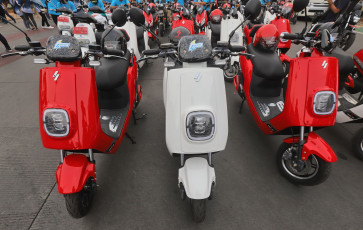Great New Xenia: A modern and strong choice for your ride
JP/R
Change text size
Gift Premium Articles
to Anyone

JP/R. Berto Wedhatama
The newly launched Daihatsu Xenia, the third generation, makes a sporty and solid impression.
The opportunity to take the Great New Xenia 1.3 R Sporty with automatic and manual transmission for a test drive from Jakarta to Cirebon in late August provided a chance to truly understand the technical innovation behind the vehicle.
The route was about 800 kilometers long, covering Jakarta'Kuningan, Cirebon via the Jakarta-Cikampek toll road and further to the Cikopo-Palimanan toll road.
The significant front and rear changes raise the class of this low multi-purpose vehicle (MPV), giving it a stronger and more modern look. In front, the bumper, engine hood and headlamps are all new. The back part flaunts its new rear combination lamps and rear bumper guard.
In the cabin, the interior design creates an atmosphere of luxury and quality. And the inside hosts a number of updated features too: the dashboard, steering wheel, seat pattern and meter combination, also with a new Multi Information Display (Type R). Its ornaments and two-tone colors also make the interior more plush and elegant, while the information presented is complete, including eco and fuel consumption indicators.
Unlike the former Xenia model, the 2015 Great New Xenia is already equipped with immobilizers for R and R Sporty types. The security system gets more attention with the presence of dual SRS (supplemental restraint system) airbags, front seat belts with pre-tensioners & force limiters and new side impact beams.
Other features that increase passenger safety and comfort are new window jam protection, rear parking sensors and new corner sensors for R Sporty and X Deluxe types. There is also increased leg room thanks to the 50:50 full-folding mechanism in the third line, enabling the transport of passengers or luggage.
With all the information, the drive started at around 8 a.m. The still-deserted toll road in the city gave a chance to try the car's acceleration, which proved to be a lot better than that of the previous generation model. Indeed, Xenia's automatic transmission may not be as powerful as its manual system, yet the acceleration capacity is sustained. The freeway with its straight and level road enabled the car to race along at a speed of 140km/hour that morning without any disturbing vibration.

Toll roads are the right place to test the quietness of the car interior. This was proven as the Great New Xenia cabin was far quieter than its predecessors. Likewise, the lowered vibration means better comfort for passengers.
On the route leading to Kuningan, as a busy ascending highway with sharp bends, the car's acceleration was smooth even by slightly forcing it to go up without gearing down.
The same was true when the car was overtaking others while ascending. Stability was also maintained on winding roads, descending as well as rising. When it was going down, the brake system worked well in spite of tough conditions. The Great New Xenia is both more comfortable and powerful than previous versions.
Satriyo Budiutomo, development project team department head of Daihatsu accompanying the test drive, said that many new technical features had been applied to this new Xenia. 'The improvements are meant to enhance comfort and increase the car's performance as a whole, with greater efficiency in the consumption of fuel,' he said.
Its strengthened construction under the front seats and in the middle tunnel with additional pads to its body improves stability and comfort due to more rigid structures, which is offset by new suspension. As a result, the car gives a softer and more stable feel while racing and turning.
The differential gear is also sturdier, which reduces vibration and better absorbs noisiness in the cabin. The Great New Xenia has its propeller system connected from the engine to the rear, thus minimizing vibration by 50 percent.
The fairly long route was rendered smooth by the Great New Xenia's newest 1.329cc Dual VVT-I, 97-horsepower engine at 6,000rpm and a maximum torsion of 121Nm at 4,000rpm. The operation of its valves is also regulated to save fuel.
The Daihatsu management has priced Great New Avanza at Rp 1 million (US$70) to Rp 5 million higher than previous models. The prices of all Great New Xenia variants range from Rp 151.65 million to Rp 205.8 million. With such attractive innovations, the Daihatsu Great New Xenia is competitive in the Low MPV segment.










